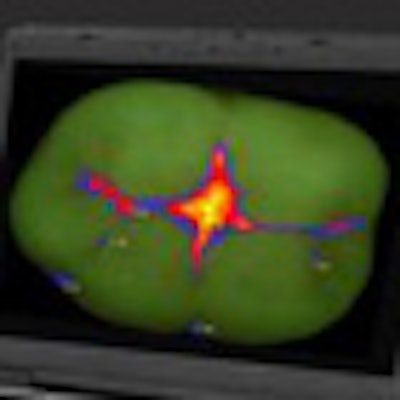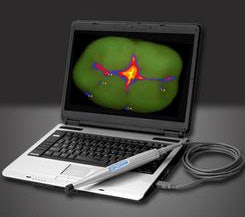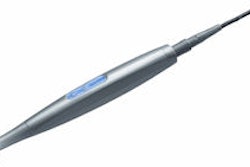
The Spectra optical caries detection device by Air Techniques is a useful adjunct for detecting, assessing, and monitoring enamel demineralization and caries progression, according to the product's first published clinical study in the Journal of Clinical Dentistry (January 2012, Vol. 23:1, pp. 1-6).
The in vitro study, conducted by a private practice pedodontist and five faculty members from the University of Medicine and Dentistry of New Jersey, is the first published clinical research to evaluate the Spectra, which received U.S. Food and Drug Administration clearance in 2009.
 Spectra optical caries detection device can image the entire spectrum of caries severity, from enamel demineralization to dentin decay. Image courtesy of Air Techniques.
Spectra optical caries detection device can image the entire spectrum of caries severity, from enamel demineralization to dentin decay. Image courtesy of Air Techniques.
The Spectra can image the entire spectrum of caries severity, from enamel demineralization to dentin decay, according to the study authors. It uses a blue light-emitting diode operating at 405 nanometers to identify caries-causing bacteria on individual teeth. The resulting image is displayed on a monitor, showing both a color and numerical reading to indicate the existence and extent of any decay, calculus, or plaque. The Spectra is the only handheld caries-detection device on the market with these capabilities, according to Air Techniques.
For this study, the researchers compared Spectra readings of occlusal surfaces to clinical, radiographic, and histological assessments of caries. Two examiners evaluated 41 extracted molars. The teeth were radiographed and then visually assessed. The International Caries Detection and Assessment System (ICDAS) was used to classify the extent of caries. The teeth were then sectioned and assigned a histological score based on the extension of caries into enamel or dentin.
Readings mirror ICDAS scores
The examiners found that 32 of the 41 teeth displayed no radiographic indications of decay and nine teeth had radiographic decay. For Spectra readings, the "no" radiographic caries group had a mean value of 1.5 ± 0.4, and the "yes" radiographic caries group had a mean value of 2.0 ± 0.2, a difference the examiners considered significant (p < 0.001).
“Spectra assists in the diagnosis of caries in both enamel and dentin.”
— Marty Jablow, DMD
In general, higher ICDAS scores were associated with higher Spectra readings, the researchers noted. Teeth with histologically evident deep dentin caries had significantly higher Spectra readings than intact teeth or teeth with superficial enamel demineralization.
"The low sensitivity and high specificity of the radiographs observed in this study agree with previous results demonstrating that radiographic diagnosis of occlusal caries is restricted to large lesions," the study authors wrote. "Significantly higher Spectra readings were observed in teeth that had radiographic occlusal caries."
The Spectra also demonstrated greater sensitivity in detecting dentin caries than radiographs, they added.
When used in conjunction with visual and radiographic examination, the Spectra is an effective means of analyzing the occlusal surface of molars and is well-suited to detecting early stages of the caries process, the researchers concluded. The Spectra can detect areas of enamel demineralization and dentin decay, as well as create a continuous scale that represents the full extent of the caries process.
Patient education tool
The Spectra can also be used to identify patients and teeth in need of preventive interventions and treatment, and to monitor lesion progression or regression over time, the study authors added.
"The Spectra provides color images and numbers to show patients the severity and extent of lesions [and] allows clinicians to save an image as well as numerical data and re-evaluate the same area at recall examinations," they wrote.
Future studies will examine the Spectra's ability to assess caries on sealed teeth and confirm the correlation between other methods of caries detection and Spectra readings within patient populations, the study authors noted. These studies should also examine the reproducibility of Spectra measurements taken under clinical conditions, they added.
"Although in vitro, this study produces results that are similar to the clinical findings we are experiencing in my practice," said Marty Jablow, DMD, a general practitioner in Woodbridge, NJ, and author of the DrBicuspid.com column Ask Marty. "Spectra assists in the diagnosis of caries in both enamel and dentin, and makes it easier to educate the patient on caries, monitor remineralization therapy, and map out a lesion when treatment is needed."



















